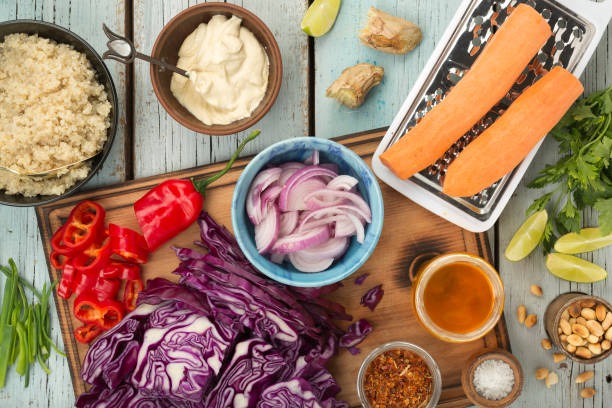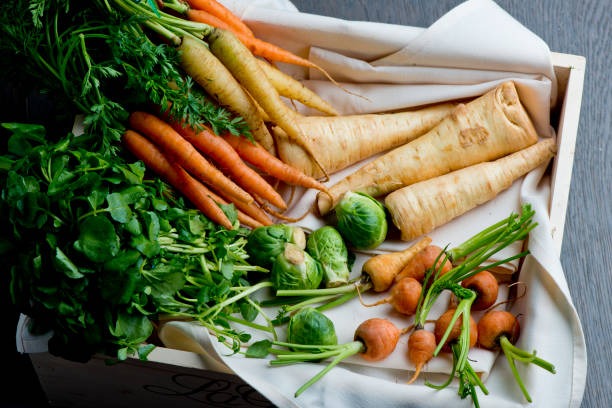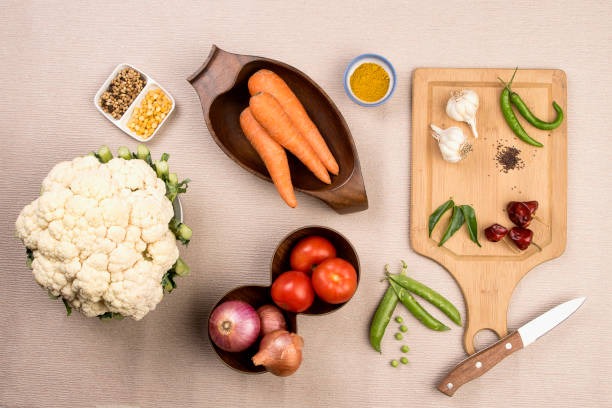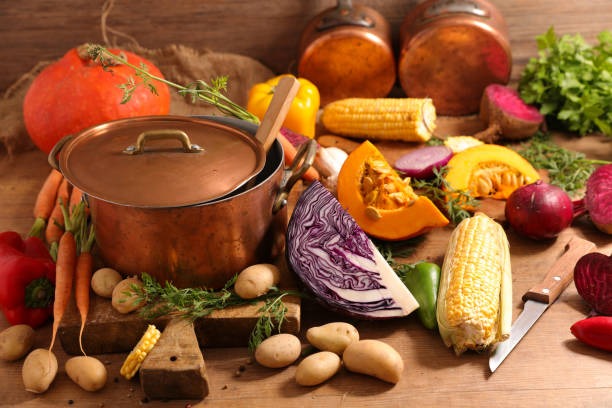Last weekend, I stumbled upon the most vibrant farmers market stall, overflowing with vegetables I’d never seen before. The farmer, weathered hands still dirty from the morning harvest, handed me a sample of the sweetest sugar snap peas I’d ever tasted. “These were picked at sunrise,” he said with a grin. “That’s the difference between eating with the seasons and eating against them.”
That moment reminded me why cooking with seasonal vegetables isn’t just a trendy movement—it’s how humans have nourished themselves for thousands of years. When you align your kitchen with nature’s calendar, something magical happens. Flavors become more intense, textures more satisfying, and your grocery budget suddenly stretches further than you thought possible.
Seasonal eating means choosing vegetables that naturally grow during specific times of the year in your geographic region. Spring brings tender greens and shoots, summer delivers juicy tomatoes and crisp cucumbers, autumn offers hearty squashes and root vegetables, while winter provides robust leafy greens and stored crops. This approach connects us to the natural rhythm of the earth while maximizing both flavor and nutrition.
The benefits extend far beyond taste. Seasonal vegetables are typically more affordable since they’re abundant during their peak growing time. They also travel shorter distances to reach your plate, making them fresher and more environmentally friendly. Plus, your body naturally craves different nutrients during different seasons—light, hydrating vegetables in summer and warming, grounding foods in winter.
Spring Vegetables: Nature’s Fresh Start

Spring vegetables embody renewal and lightness after winter’s heavy comfort foods. These early crops are packed with vitamins and minerals your body craves after months of stored vegetables and preserved foods.
Asparagus: The Herald of Spring
Asparagus spears push through the soil as soon as winter’s grip loosens, making them one of spring’s first gifts. These elegant vegetables are best when pencil-thin to medium thickness, with tight, compact tips and vibrant green color. Avoid spears that look woody at the bottom or have begun to flower at the top.
The key to perfect asparagus lies in not overcooking it. A quick sauté, light steam, or brief grill maintains its crisp texture and bright flavor. I’ve found that snapping asparagus at its natural breaking point removes the tough, fibrous ends without waste.
Grilled Asparagus Salad Recipe:
Toss 1 pound trimmed asparagus with olive oil, salt, and pepper. Grill for 3-4 minutes until lightly charred but still crisp. Arrange on a platter with mixed greens, shaved Parmesan, toasted pine nuts, and a simple lemon vinaigrette. The smokiness from grilling adds depth while maintaining asparagus’s delicate spring character.
Peas: Sweet Spheres of Spring
Fresh peas are one of spring’s sweetest rewards, though their season is frustratingly brief. Unlike their frozen counterparts, fresh peas have a crisp texture and natural sweetness that deteriorates quickly after harvest. Look for bright green, plump pods that feel heavy for their size.
Shell peas just before cooking to preserve their natural sugars. The difference between freshly shelled peas and those that have sat around is remarkable—fresh peas taste almost floral, while older ones become starchy and bland.
Pea and Mint Soup Recipe:
Sauté 1 diced onion in butter until soft. Add 2 cups fresh or frozen peas, 3 cups vegetable broth, and simmer for 5 minutes. Blend until smooth, then stir in fresh mint leaves, a splash of cream, salt, and white pepper. Serve chilled or warm with a dollop of crème fraîche.
Summer Vegetables: Peak Season Abundance

Summer vegetables celebrate the sun’s power with bold flavors, vibrant colors, and high water content perfect for hot weather. This season offers the year’s greatest variety and abundance.
Tomatoes: Summer’s Crown Jewel
A perfectly ripe tomato embodies everything wonderful about summer cooking. The difference between a grocery store tomato and a vine-ripened, sun-warmed specimen is profound—one tastes like cardboard while the other bursts with sweet, acidic complexity.
Choose tomatoes that yield slightly to gentle pressure and smell fragrant at the stem end. Never refrigerate tomatoes, as cold temperatures destroy their flavor compounds and create a mealy texture. Instead, store them stem-side down at room temperature.
Heirloom Tomato Salad Recipe:
Slice 3-4 different varieties of ripe heirloom tomatoes into thick rounds. Arrange on a platter, alternating colors and sizes. Sprinkle with flaky sea salt, torn fresh basil, and crumbled goat cheese. Drizzle with your best olive oil and aged balsamic vinegar. Sometimes the simplest preparations showcase ingredients best.
Zucchini: The Prolific Summer Squash
Zucchini grows so enthusiastically that gardeners often joke about leaving bags of it on neighbors’ doorsteps. This versatility makes zucchini a summer cooking essential, adapting to both savory and sweet preparations.
Select small to medium zucchini with glossy, unblemished skin. Larger specimens tend to be watery with tough seeds. Zucchini’s mild flavor makes it perfect for absorbing other ingredients while adding moisture and nutrition.
Zucchini Bread Recipe:
Grate 2 cups zucchini and squeeze out excess moisture. Mix with 1½ cups flour, ½ cup sugar, ¼ cup brown sugar, 1 egg, ⅓ cup oil, 1 tsp vanilla, 1 tsp baking soda, ½ tsp salt, and 1 tsp cinnamon. Fold in chopped walnuts if desired. Bake at 350°F for 50-60 minutes until a toothpick comes out clean.
Autumn Vegetables: Harvest Comfort
Autumn vegetables prepare us for winter with hearty, warming qualities. These vegetables store well and provide the comfort food cravings that emerge as temperatures drop.
Squash: Autumn’s Golden Gift
Winter squashes like butternut, acorn, and delicata offer natural sweetness and creamy textures perfect for cool weather cooking. Look for squash that feels heavy for its size with hard, unblemished skin and a dull finish rather than shiny.
The natural sugars in winter squash intensify through roasting, creating caramelized edges and silky interiors. Most varieties can be stored for months in a cool, dry place, making them valuable winter staples.
Butternut Squash Risotto Recipe:
Roast 2 cups cubed butternut squash with olive oil, salt, and pepper at 400°F for 25 minutes. Meanwhile, prepare risotto by slowly adding warm broth to Arborio rice, stirring constantly. Fold in roasted squash, Parmesan cheese, butter, and fresh sage. The squash adds natural sweetness and creamy texture to the risotto.
Brussels Sprouts: Mini Cabbages with Big Flavor
Brussels sprouts have undergone a culinary renaissance, moving from the most hated vegetable to restaurant menu darling. The secret lies in proper cooking techniques that highlight their nutty sweetness while eliminating bitterness.
Choose small, tight Brussels sprouts with bright green leaves. Avoid yellowing or loose leaves, which indicate age. Remove any damaged outer leaves and trim the stem end, but don’t remove too much or the leaves will fall apart.
Roasted Brussels Sprouts with Balsamic Glaze Recipe:
Halve 1 pound Brussels sprouts and toss with olive oil, salt, and pepper. Roast cut-side down at 425°F for 20-25 minutes until caramelized. Meanwhile, reduce ½ cup balsamic vinegar with 2 tbsp honey until syrupy. Drizzle over sprouts and garnish with toasted pine nuts.
Winter Vegetables: Cold Weather Champions

Winter vegetables provide hearty nutrition when fresh options are limited. These robust vegetables store well and offer the warming qualities our bodies crave during cold months.
Kale: The Hardy Green Giant
Kale actually improves after frost, developing a sweeter flavor as cold temperatures convert starches to sugars. This nutritional powerhouse remains productive long after other greens have succumbed to winter weather.
Choose kale with firm, deeply colored leaves and avoid yellowing or wilted specimens. Remove tough stems before cooking, though tender stems on young kale are perfectly edible.
Kale and White Bean Stew Recipe:
Sauté 1 diced onion, 2 minced garlic cloves, and 1 diced carrot in olive oil. Add 4 cups vegetable broth, 2 cans white beans, 1 bunch chopped kale, and 1 tsp dried thyme. Simmer 15 minutes until kale is tender. Season with salt, pepper, and a splash of lemon juice.
Root Vegetables: Underground Treasures
Carrots, parsnips, turnips, and other root vegetables store energy underground, making them naturally sweet and satisfying. These vegetables were historically crucial for winter survival and remain comfort food classics.
Look for firm root vegetables without soft spots or extensive root hair growth. Smaller specimens are often sweeter and more tender than large ones. Most root vegetables benefit from roasting, which concentrates their natural sugars.
Roasted Root Vegetable Medley Recipe:
Cut 2 lbs mixed root vegetables (carrots, parsnips, turnips, sweet potatoes) into uniform pieces. Toss with olive oil, fresh thyme, salt, and pepper. Roast at 425°F for 30-40 minutes, stirring once, until caramelized and tender. Finish with fresh herbs and a drizzle of honey.
Essential Tips for Cooking with Seasonal Vegetables
Selecting the freshest vegetables requires using all your senses. Look for vibrant colors, firm textures, and absence of soft spots or blemishes. Fresh vegetables should smell pleasant—earthy, sweet, or grassy—never sour or off-putting.
Shopping at farmers markets connects you directly with growers who can share harvesting dates and storage tips. Building relationships with local farmers often leads to discovering new varieties and getting first access to seasonal specialties.
Best Cooking Methods for Each Vegetable Type

Different vegetables benefit from specific cooking techniques that highlight their unique characteristics:
- Leafy greens (spinach, kale, chard): Quick sauté, steam, or raw in salads
- Cruciferous vegetables (broccoli, cauliflower, Brussels sprouts): Roast, steam, or stir-fry
- Root vegetables (carrots, beets, potatoes): Roast, braise, or slow-cook
- Summer squash (zucchini, yellow squash): Grill, sauté, or spiralize raw
- Winter squash (butternut, acorn): Roast, purée, or slow-cook
Understanding these basic principles helps you adapt recipes and experiment with confidence.
The Science Behind Seasonal Eating
Eating seasonally aligns with both nutritional science and human evolution. Seasonal vegetables typically contain higher nutrient levels when consumed during their natural growing season because they’re harvested at peak ripeness and don’t require long-distance transportation.
Vitamin C content in vegetables can decrease by up to 50% within a week of harvest, making locally grown, seasonal produce significantly more nutritious than out-of-season alternatives shipped from distant locations.
The natural variation in seasonal eating also provides dietary diversity that supports optimal health. Spring vegetables are often high in detoxifying compounds, summer produce provides hydration and antioxidants, autumn harvest offers energy-storing carbohydrates, and winter vegetables supply warming nutrients and stored vitamins.
Frequently Asked Questions
What if I live in a climate with limited growing seasons?
Even in harsh climates, you can eat seasonally by focusing on storage crops like root vegetables, squash, and preserved foods during winter months. Many cold-climate vegetables actually improve in flavor after frost exposure.
Are frozen vegetables considered seasonal?
Frozen vegetables can be part of seasonal eating when they’re processed at peak freshness during their natural season. Flash-freezing preserves many nutrients, making frozen options sometimes more nutritious than fresh vegetables that have traveled long distances.
How do I know what’s in season in my area?
Visit local farmers markets, join a community-supported agriculture (CSA) program, or consult seasonal produce guides specific to your region. Many agricultural extension offices provide seasonal eating calendars for their areas.
Is seasonal eating more expensive?
Seasonal eating often costs less because vegetables are abundant during their peak season, driving prices down. However, shopping at farmers markets for premium varieties might cost more than conventional grocery store options.
Can I preserve seasonal vegetables for later use?
Absolutely! Freezing, canning, fermentation, and dehydration allow you to enjoy seasonal flavors year-round. Many preservation methods also add unique flavors and textures to vegetables.
People Also Ask
What vegetables are in season right now?
This depends on your location and current season. In general, spring brings asparagus and peas, summer offers tomatoes and zucchini, autumn provides squash and Brussels sprouts, while winter features kale and root vegetables.
How do you store seasonal vegetables?
Storage methods vary by vegetable type. Leafy greens need refrigeration with humidity, root vegetables prefer cool, dry conditions, and tomatoes should never be refrigerated. Most vegetables should be stored unwashed until use.
What’s the difference between seasonal and local eating?
Seasonal eating focuses on consuming foods during their natural growing season, while local eating emphasizes proximity to where food is grown. The two concepts often overlap but aren’t identical.
Why do seasonal vegetables taste better?
Seasonal vegetables are harvested at peak ripeness when their flavor compounds are most developed. They also travel shorter distances and spend less time in storage, preserving taste and texture.
Embrace Nature’s Perfect Timing
Cooking with seasonal vegetables transforms your relationship with food from mere consumption to meaningful connection with the natural world. Each season brings its own gifts—spring’s tender emergence, summer’s abundant celebration, autumn’s generous harvest, and winter’s sustaining comfort.
Start small by incorporating one or two seasonal vegetables into your weekly meal planning. Visit a local farmers market and strike up conversations with growers. Try one new seasonal recipe each month. Before long, you’ll find yourself naturally craving foods that align with the season, just as our ancestors did for millennia.
The path to better eating isn’t complicated—it simply requires paying attention to what nature offers when she offers it. Your taste buds, your wallet, and your health will thank you for working with the seasons rather than against them.
Meta data
Meta title
Cook with Seasonal Vegetables: Complete Guide + Easy Recipes
Meta description
Discover the art of cooking with seasonal vegetables. Learn which vegetables to use each season, plus delicious recipes and expert tips for better meals.

